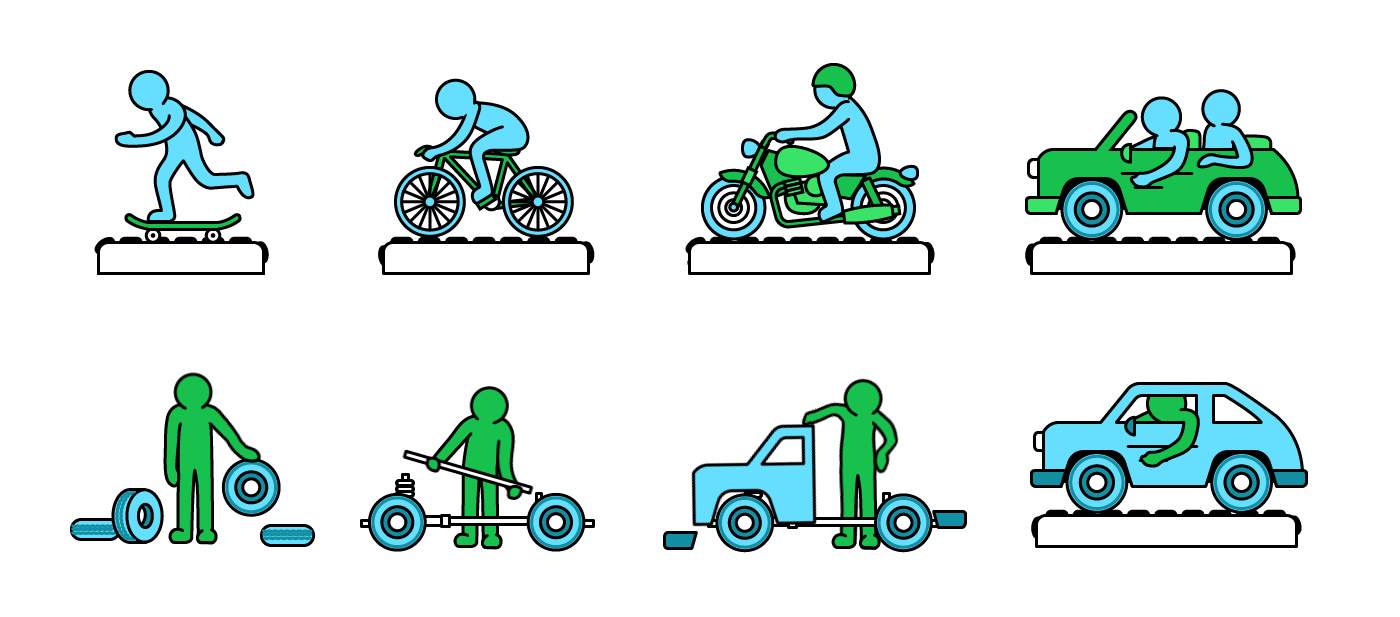🧑🏿🤝🧑🏾 day-plan
Delivery is the catch-all term for shipping your code, or putting it in online, in a public place where real people can use it.
Telephone
Ring Ring Bananaphone
In groups of no more than 5, we’re going to play a game of telephone.
Ring Ring Bananaphone
To play Telephone without the internet, you will need: pens, paper, a stopwatch or timer
- In groups of no more than 6, give each person a pen and a sheet of paper. You might want to pre-fold the paper into thirds or sixths so people know how big to draw
- Alternating around the group, choose Red/Yellow/Red/Yellow/Red/Yellow
- Faciliator: Shout telephone! and set a timer for 30 seconds (a tomato timer is good for this)
- All the Reds: draw a picture
- All the Yellows: write a sentence
- When the timer rings, fold the paper over and pass it left
- Faciliator: Shout telephone! and set a timer for 30 seconds: it’s 30 seconds a round.
- Players: Look at your new picture or sentence. Do your best to draw the sentence or write the picture.
- When the timer rings, fold the paper over and pass it left
- Continue until your starting paper returns to you
Tabs .Page.File.Path = blocks/telephone/index.md
Tabs page.File.Path = fundamentals/sprints/3/day-plan/index.md
Sharing Our Blockers
Learning Objectives
We call problems that stop our progress “blockers”. We talk through our blockers regularly and help each other get “unblocked” or “unstuck”.
Sharing Our Blockers
Join the Jam board or grab some sticky notes. Add your blockers.
Make sure to add only one blocker per note.
Morning Break
A quick break of fifteen minutes so we can all concentrate on the next piece of work.
Present CYF Blocks project 🔗
Learning Objectives
Preparation
Introduction
Everybody has to explain themselves and persuade others of their ideas. Giving a formal presentation is one way of doing that. You know the topic. You want the other people to understand it too.
When presenting, you should remember your message. Be careful that everything you do and say helps the audience understand.
Exercises
Give a 3-minute presentation
Goal: Give a presentation to an audience about a planned topic. (20 minutes)
- In groups of 3 people, each person should give a 3-minute presentation about CYF Blocks.
- Give the other speakers feedback about how good their presentation was. Did they cover the following:
- The goal of the presentation and a summary.
- Necessary background information that the audience may not know.
- Main points.
- Conclusion.
- Make notes of the feedback you received and think about how you can apply it next time.
Present your content to different audiences
Goal: Give a presentation to an audience about a planned topic. (20 minutes)
- In the same groups of 3 people, take turns giving a 1-minute presentation to each audience.
- Tell them what benefit they will gain from listening. Tell them the first half of a story or promise a benefit to the audience if they pay attention, such as learning something new.
- Give the other person feedback about how well they adapted to their audience.
Community Lunch
Every Saturday at CYF we cook and eat together. We share our food and our stories. We learn about each other and about the world. We build community.
Ship It
Learning Objectives
Tip
Today we will spend most of our time working together on our projects in timed bursts of 25 minutes. This is called the Pomodoro Technique, and it will help you manage your self study. On the 5 minute break, get up from your computer and move your body: stretch! This is hard work. We will develop and then ship our code repeatedly throughout the day. Each time we ship, we will ship something that works.
- Pick one of the CYF Blocks projects and ship it to your website
- Choose a way to improve upon the project to make it better suited to your website. Modify your CYF Blocks implementation then ship it!
- Get feedback from one of your peers: what new requirement would they like to add? Can you implement this in CYF Blocks? Ship it again!

How will you work together? Using the collaborative tools you have learned during this course:
You are part of a cohort
- together: identify your blockers
- in small groups: define your goals as user stories
- in pairs: iteratively improve your products
Wrap Up
Learning Objectives
Reflection on Fundamentals
We have worked together over these weeks exploring some of what it means to be a software developer. If you have met the criteria you will now be invited to join the Software Development Course. Let’s think together about what software developers really do.
What do developers do (5 mins)
Join the Jam board/grab some sticky notes and add your ideas.
Make sure to add only one idea per note.
Mentors will now lead a reflection and then we will do our last retro!
Retro: Start / Stop / Continue
Retro is a chance to reflect on this past sprint. You can do this on a Jamboard (make sure someone clicks “Make a copy” before you start, and you work on that together) or on sticky notes on a wall.Retro (20 minutes)
warning: name is empty 🔗
Youtube .Page.File.Path = blocks/retro/index.md
Youtube page.File.Path = fundamentals/sprints/3/day-plan/index.md